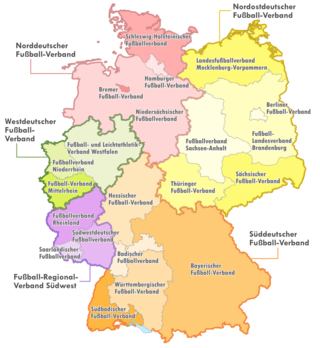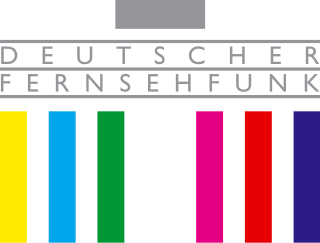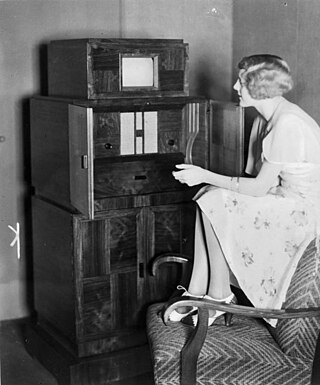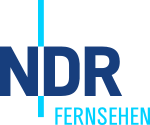
ARD is a joint organisation of Germany's regional public-service broadcasters. It was founded in 1950 in West Germany to represent the common interests of the new, decentralised, post-war broadcasting services – in particular the introduction of a joint television network.
Das Erste is the flagship national television channel of the ARD association of public broadcasting corporations in Germany. Das Erste is jointly operated by the nine regional public broadcasting corporations that are members of the ARD.
Westdeutscher Rundfunk Köln, shortened to WDR, is a German public-broadcasting institution based in the Federal State of North Rhine-Westphalia with its main office in Cologne. WDR is a constituent member of the consortium of German public-broadcasting institutions, ARD. As well as contributing to the output of the national television channel Das Erste, WDR produces the regional television service WDR Fernsehen and six regional radio networks.

The Oberliga is the fifth tier of the German football league system. Before the introduction of the 3. Liga in 2008, it was the fourth tier. At the end of the 2011–12 season the number of Oberligas was increased from eleven to fourteen.
Television in Germany began in Berlin on 22 March 1935, broadcasting for 90 minutes three times a week. It was home to the first regular television service in the world, named Fernsehsender Paul Nipkow.

Norddeutscher Rundfunk, commonly shortened to NDR, is a public radio and television broadcaster, based in Hamburg. In addition to the city-state of Hamburg, NDR broadcasts for the German states of Lower Saxony, Mecklenburg-Vorpommern and Schleswig-Holstein. NDR is a member of the ARD organisation.
Radio Bremen, shortened to RB is Germany's smallest public radio and television broadcaster and the legally mandated broadcaster for the city-state Free Hanseatic City of Bremen. With its headquarters sited in Bremen, Radio Bremen is a member of the consortium of German public broadcasting organizations, ARD.
Sender Freies Berlin was the ARD public radio and television service for Berlin from 1 June 1954 until 30 April 2003. On 1 January 1992, SFB became the public broadcaster for the whole of reunited Berlin. However, SFB had long had a significant audience in East Berlin for some time before German reunification. On 1 May 2003 it merged with Ostdeutscher Rundfunk Brandenburg to form Rundfunk Berlin-Brandenburg.

The Oberliga Hamburg/Schleswig-Holstein was the fourth tier of the German football league system in the north of Germany, existing from 1994 to 2004. It covered the states of Hamburg and Schleswig-Holstein. With the re-formation of the Oberliga Nord in 2004, the league was disbanded.

The Gauliga Nordmark was the highest football league in the Prussian Province of Schleswig-Holstein and the German states of Hamburg, Lübeck, Mecklenburg-Schwerin, Mecklenburg-Strelitz and parts of Oldenburg from 1933 to 1945. Shortly after the formation of the league, the Nazis reorganised the administrative regions in Germany, and the GaueHamburg, Mecklenburg and Schleswig-Holstein replaced the Prussian province and the German states in this northern region of Germany.

Deutscher Fernsehfunk was the state television broadcaster in the German Democratic Republic from 1952 to 1991.

The first regular electronic television service in Germany began in Berlin on March 22, 1935, as Deutscher Fernseh Rundfunk. Broadcasting from the Fernsehsender Paul Nipkow, it used a 180-line system, and was on air for 90 minutes, three times a week. Very few receivers were ever privately owned, and viewers went instead to Fernsehstuben. During the 1936 Summer Olympics, broadcasts, up to eight hours a day, took place in Berlin and Hamburg. The Nazis intended to use television as a medium for their propaganda once the number of television sets was increased, but television was able initially to reach only a small number of viewers, in contrast to radio. Despite many technical improvements to camera technology, allowing for higher resolution imaging, by 1939, and the start of World War II, plans for an expansion of television programming were soon changed in favor of radio. The production of the TV receiver E1, that had just started was cancelled because of the war. Nevertheless, the Berlin station, along with one in occupied Paris, remained on the air for most of World War II. A special magazine called Fernsehen und Tonfilm was published.
The Biela Valley Trolleybus was a trolleybus service in the German state of Saxony. The facility opened on 10 July 1901 and had closed again by September 1904. It was one of the first trolleybus operations in the world. The 4.4-kilometre route was also known at the time as the Gleislose Bahn or "trackless railway" – its full name being Gleislose Bielathal-Motorbahn mit elektrischer Oberleitung. It was operated by the firm of Bielathal-Motorbahn Königstein and served the lower valley of the Biela in Saxon Switzerland. The route linked Königstein on the Elbe with the then-independent village of Hütten. The terminus was at Kurbad Königsbrunn.

The Eberswalde trolleybus system serves the city of Eberswalde, in the Land of Brandenburg, Germany.
Radio Bremen TV is a regional public service television channel owned and operated by Radio Bremen (RB) and serving Bremen, Germany. It is one of seven regional "third programs". The name reflects the fact these programs all came into existence after the Second German Channel was founded in 1961. They are organized within the federal network ARD.
The State Office for the Protection of the Constitution is a state-level security agency in Germany.

The Hanseatisches Oberlandesgericht is the Higher Regional Court (OLG) of the Free and Hanseatic City of Hamburg, Germany, and thus part of the Hamburg ordinary jurisdiction. It is located at the square of Sievekingplatz in the St. Pauli quarter. The square is named after the first president of the OLG, Ernst Friedrich Sieveking.
RBB Berlin was the third television channel for Berlin, Germany from October 1992 until March 2004. Until May 2003 it was owned by Sender Freies Berlin (SFB), then by its successor, Rundfunk Berlin-Brandenburg (RBB), under the provisional name RBB Berlin. On 1 March 2004, the two previous regional television channels RBB Berlin and RBB Brandenburg were replaced by the new rbb Fernsehen.
RBB Brandenburg was the third television channel for Brandenburg, (Germany) from January 1992 to March 2004. Until May 2003, it was organized by Ostdeutscher Rundfunk Brandenburg (ORB), then by its successor, Rundfunk Berlin-Brandenburg (RBB). On 1 March 2004, the two regional television channels of RBB – RBB Brandenburg and RBB Berlin – were integrated into the new rbb Fernsehen.













